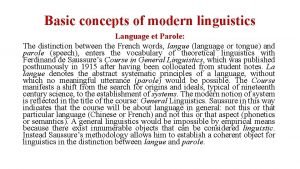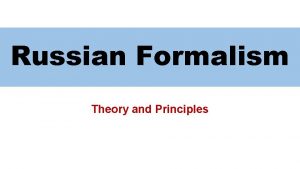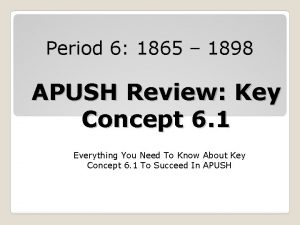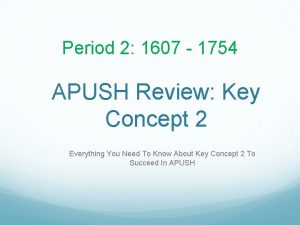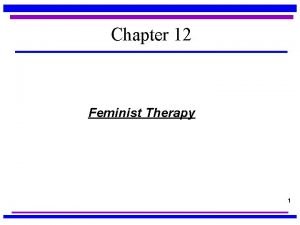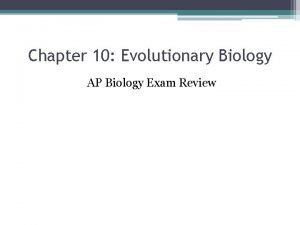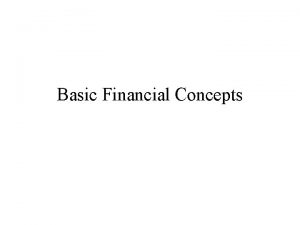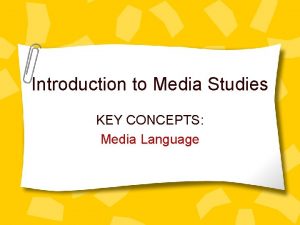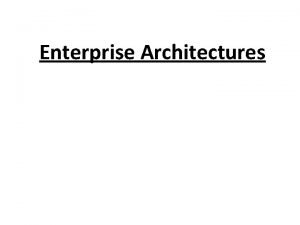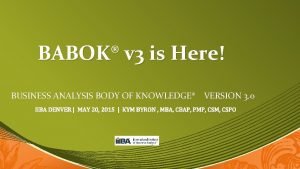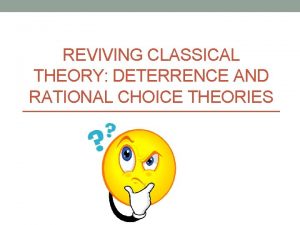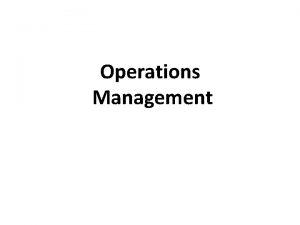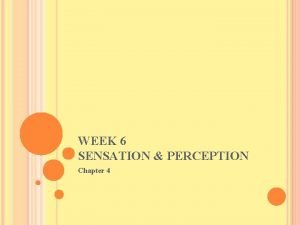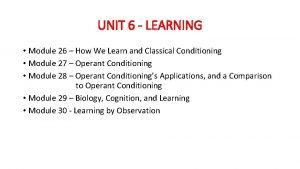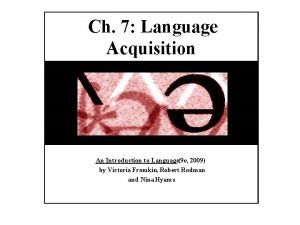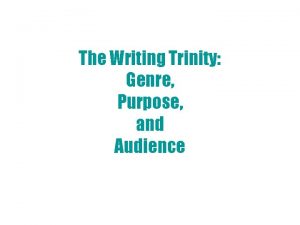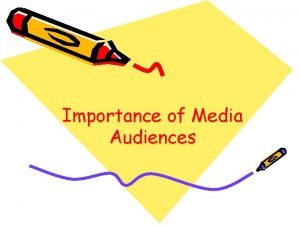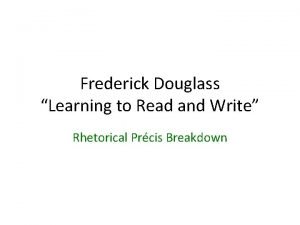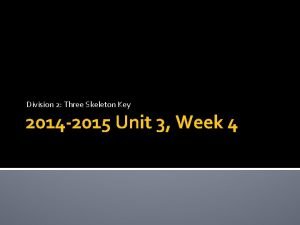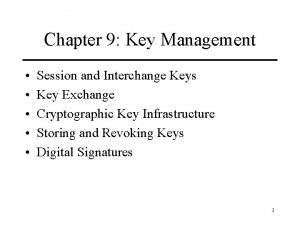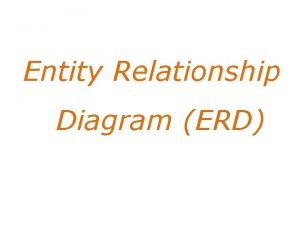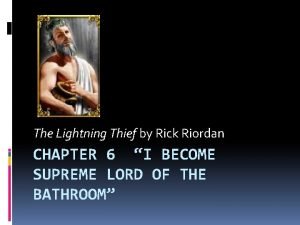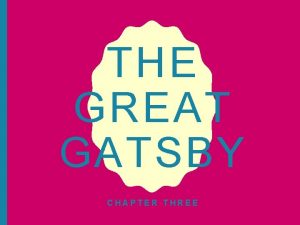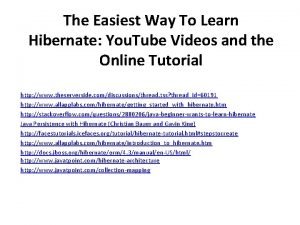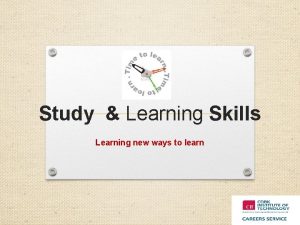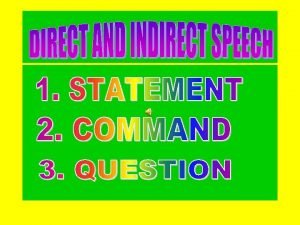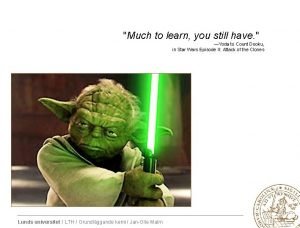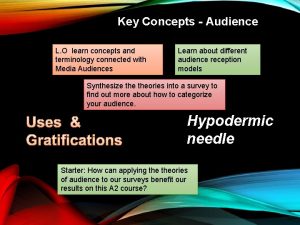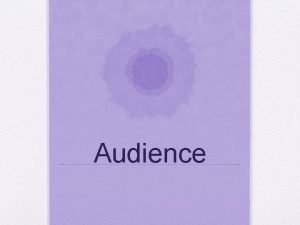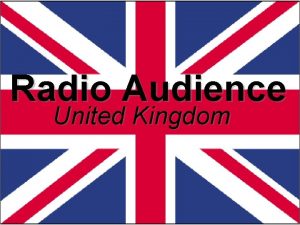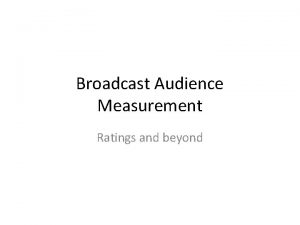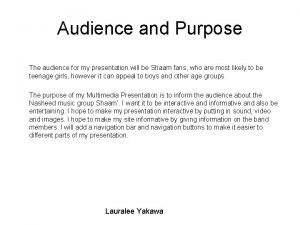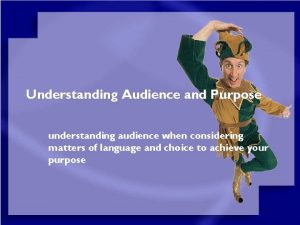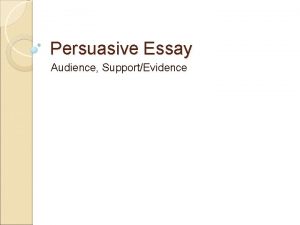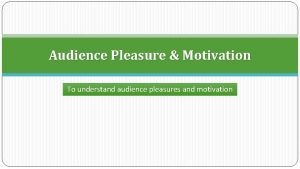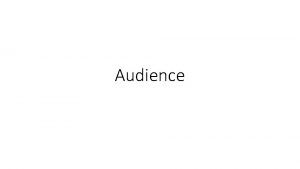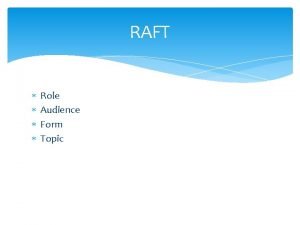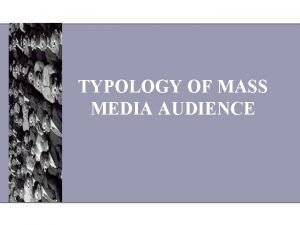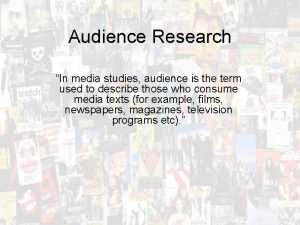Key Concepts Audience L O learn concepts and

























































































- Slides: 89

Key Concepts - Audience L. O learn concepts and terminology connected with Media Audiences Learn about different audience reception models Learn about Maslow’s Hierarchy of needs U & G Hypodermic needle Starter: Why is it appropriate to talk about media audiences rather than audience? MARS

“GEARS” Audiences can be defined by their

MASLOW’S HIERARCHY OF NEEDS

Watch VW The force http: //www. youtube. com/watch? v=R 55 e-u. HQna 0 2012 TV / cinema Ad made by the agency Deutsch VERULAM MEDIA STUDIES This is a perfect example of INTERTEXTUALITY Target audience? Use GEARS How does it appeal to audience? Greed? Flattery? Envy? Is there a link to Maslow’s Hierarchy of Needs?

Hypodermic Needle Model Uses & Gratifications Model Audiences are active in choosing media for their own ‘gratifications’ (pleasure) Audiences are passive Easily led, influenced & manipulated Gullible, sheep-like fashion-followers Media consumption influences the attitudes and behaviour of audiences Sometimes called ‘magic bullet’ theory Linked to propaganda & advertising Behaviourist models of human behaviour Links to Maslow’s Hierarchy of Needs Developed by Blumler& Katz Main reasons for using media: Personal Identity – to define who we are (sometimes called self-surveillance) Information Entertainment – includesescape, distraction Social Interaction – to help us socialise with like-minded people

AS Level Watch 3 adverts and analyse which of Maslow’s needs is most relevant. There may be more than one A 2 Can Maslow’s Hierarchy of needs be applied to areas of media other than advertising? Pros and cons of the Model How does Maslow’s Hierarchy relate to the Uses and Gratifications Model of Media reception. Case study: How would Maslow’s ideas fit into TV comedy such as ‘Outnumbered’?

The traditional segmentation model

(Young & Rubicam’s 4 Cs model) cross cultural consumer characterization model

Model answer Lovely things-mainstream, the resigned Mean Green-the reformer, explorer Things to back up points: Paradigms of iconography Semiotics-how people are dressed, use of animals Audio-heavy rock vs Julie Andrews Sound of Music Genre conventions Representations of audience needs according to 4 Cs model

Young & Rubicam 4 Cs model Cross-Cultural Consumer Characterisation model A more useful audience segmentation model than the traditional ABC 1 categorization. It acknowledges the global nature of media audiences Divides audiences into 7 types of consumer 4 main categories are (MARS) MAINSTREAMERS, ASPIRERS, REFORMERS, SUCCEEDERS The other categories to be added to this are (ERS) EXPLORER RESIGNED STRUGGLER It takes the following as consumer motivations: SECURITY, CONTROL, STATUS, INDIVIDUALITY, FREEDOM, SURVIVAL and ESCAPE Clear links with Maslow

Click here for more info on Maslow, 4 Cs and audience segmentation AS – use the BA’ To Fly to Serve’ TV advert and work out which of the 7 4 Cs audience categories is being targeted A 2 Use 4 C’s to do an audience segmentation analysis of two contrasting ads e. g. Skoda Fabia ‘Full of Lovely Stuff and the later Skoda Fabia ‘mean green’ What are the advantages of the Young and Rubicam 4 C model? Outline some of the disadvantages.

Other audience segmentation models.

Market research companies often come up with other ways of segmenting audience/ consumers

Another Lifestyle type model for audience demographics

1 Nothing is original 2 Parody & Pastiche 3 Bricolage 4 Self-reflective 5 Hybrid 6 Blurring of trad. boundaries 7 mix of high & low culture 8 Form over content 9 Intertextuality Postmodernism Baudrillard Hyperreality Mentioned in the Matrix Match these up with the definitions on the left: a) Aesthetics b) Imitation c) Simulation, replica, duplication d) Mixing styles/genres e) Sticking together random elements f) One text referring to another g) e. g. male/female h) Aware of its own status as construction i) e. g. Ballet & breakdance In what ways is QI postmodern? Think of other media examples Music? Facebook?

A Parody is a work that mimics in an absurd or ridiculous way the conventions and style of another work - in order to derive ridicule, ironic comment or affectionate fun.

Parody Some genre theorists see parody as a natural development in the life cycle of any genre. Such theorists note that Western movies, for example, after the classic stage defined the conventions of the genre, underwent a parody stage, in which those same conventions were ridiculed and critiqued. Because audiences had seen these classic Westerns, they had expectations for new Westerns, and when these expectations were subverted, the audience laughed.

Parody Most of the humour in recent parodies of film genres is based on our familiarity with formula plots, conventions and characters. Films like Scary Movie, Not Another Teen Movie and Team America: World Police first build on our habitual expectations of their genre and then violate them. Because each of these films incorporates the plot, characters & conventions of dozens of films, they can be helpful in studying the genres they parody.

Self-Parody A subset of parody is self -parody in which artists satirize themselves (such as in Ricky Gervais' Extras) or their work (e. g. Antonio Banderas' Puss in Boots in Shrek 2), or an artist or genre repeats elements of earlier works to the point that originality is lost (e. g. Sylvester Stallone in Rocky Balboa).

Intertextuality is the shaping of texts' meanings by other texts. It can refer to an author’s borrowing and transformation of a prior text or to a reader’s referencing of one text in reading another.

Intertextuality • The term intertextuality has, itself, been borrowed and transformed many times since it was coined by poststructuralist Julia Kristeva in 1966. As critic William Irwin says, the term “has come to have almost as many meanings as users, from those faithful to Kristeva’s original vision to those who simply use it as a stylish way of talking about allusion and influence” (Irwin, 228). • ''Against Intertextuality''. Philosophy and Literature, v 28, Number 2, October 2004

A pastiche is “a medley of various ingredients; a hotchpotch, farrago, jumble. ” The term denotes a technique employing a generally lighthearted tongue-in-cheek imitation of another's style; although jocular, it is usually respectful (as opposed to parody, which is not).

Pastiche is prominent in popular culture. Many genre pieces, particularly in fantasy, are essentially pastiches. George Lucas’ Star Wars series is often considered to be a pastiche of traditional science fiction television serials or radio shows.

The films of Quentin Tarantino are often described as pastiches, with their mixing and blurring of generic conventions and boundaries. Kill Bill (2003) pays tribute to (or perhaps imitates) numerous genres; pulp novels, blaxploitation, grindhouse, kung fu and western films - though some say his films are more of a homage.

Homage is generally used to mean any public show of respect to someone to whom you feel indebted. In this sense, a reference within a creative work to someone who greatly influenced the artist would be a homage (for example, Johnathan Glazer’s music video for Blur’s The Universal payed homage to Stanley Kubrick’s film Clockwork Orange).

Satire is a technique in which a e target is held up for merciless ridicule. Because satire often combines anger and humour it can be profoundly disturbing because it is essentially ironic & sarcastic - it is often misunderstood. Although satire is usually witty, and often very funny, the primary purpose of satire is not primarily humour but criticism of an individual or a group in a witty manner.

Exam style question AS: What is the BBC hoping to achieve by including behind the scenes footage? (12 marks) (15 mins) A 2: Is the media able to challenge traditional representations of femininity? You should refer to other media products to support your answer. (12 marks) (15 mins)

AS: What is the BBC hoping to achieve by including behind the scenes footage? (12 marks) (15 mins) The question tests knowledge and understanding of media institutions, specifically the institution’s aims and objectives in creating a media product. Anticipated content: This is a guide to what might be expected in students’ answers. However it is not exhaustive. Be prepared to accept original and different ideas. Ultimately students should be rewarded for what they have achieved, not penalised for what they may have omitted. The BBC’s aims/objectives potentially include: Positive brand image (expertise) Promotion of association with technology Fulfilment of remit (educate/inform/entertain) Justification of high budget (and licence fee) Showcase of high production values Personification (humour and dedication of crew) Level 4 (10 -12 marks) Thorough knowledge and understanding of a wide range of the institution’s aims/objectives, demonstrated by detailed reference to the product and confident use of media terminology. Level 3 (7 -9 marks) Sound knowledge and understanding of several of the institution’s aims/objectives, demonstrated by solid reference to the product and proficient use of media terminology. Level 2 (4 -6 marks) Some knowledge and understanding of some of the institution’s aims/objectives, demonstrated by some reference to the product and some adequate use of media terminology.

A 2: Is the media able to challenge traditional representations of femininity? You should refer to other media products to support your answer. (12 marks) (15 mins) Level 4 (10 -12 marks) A sophisticated and detailed evaluation, showing very good critical autonomy. Sophisticated and detailed application of a wide range of wider contexts. Supports answer with a wide range of examples from other media. Articulate and engaged. Level 3 (7 -9 marks) A proficient evaluation, showing good critical autonomy. Proficient application of a range of wider contexts. Supports answer with a range of examples of other media. Clearly expressed. Level 2 (4 -6 marks) A satisfactory evaluation, showing critical autonomy. Adequate application of a number of wider contexts. Supports answer with examples from other media. Generally clear expression.

NARRATIVE & GENRE THEORY LINK the following: Todorov Propp Levi-Strauss Todorov: Equilibrium Disruption Resolution Is genre dead? 8 character types Binary opposition 3 part structure Once upon a time … and they all (nearly) lived happily ever after Hybrid vs pure Syd Field: 3 act structure Set-up conflict /confrontation Resolution / Pay off Narrative frame Backstory Flashback Flash forward Sequel & prequel enigma (non) -linear multistrand Fractured/ fragmented narrative Open(-ended) vs closed Series vs serial Cliff-hanger Repertoire of elements Iconography Repetition & variation Repetition & difference iconography Who is telling the story? For whom? Why? Purpose? Message? Motivation? How do we know? MEDIATION - filtering, omission, selecting, ordering emphasis (foregrounding)

Apply Todorov’s three part structure to this Name some character types from Propp.

Define these 1 Nothing is original 2 Parody & Pastiche 3 Bricolage 4 Self-reflective 5 Hybrid 6 Blurring of trad. boundaries 7 mix of high & low culture 8 Form over content 9 Intertextuality

Director of a film has full creative control; Not the producer or film company (studio) Auteur Theory See: Music video – Chris Cunningham, Spike Jonze, David Fincher Director controls every aspect of the production process Like an author, the film is their personal vision The style is Distinctive Original Quirky Individual Alfred Hitchcock Stanley Kubrick Tim Burton Wes Anderson Quentin Tarantino They reject: - Producer/ studio led domination - genre - High concept franchise films

Section A-Charlie and the Chocolate Factory and Alice in Wonderland • How does Tim Burton use mise-en-scene to create impact? • How does the institution take an original approach to contemporary remakes? • Why do these films appeal to such a wide audience? • How is the concept of dream represented within these two films?

How does Tim Burton use mise-enscene to create impact? Alice In Wonderland Charlie and The Chocolate factory • Grey/chrome filters to represent real world • Iconography-use of stormy skies/change of Alice’s dress and hair as she becomes independent • CGI-distorted reality-hyper reality? Fantasy genre elements • Iconography representing good/evil through setting/character appearance. Binary opposites. • High key/neon filters in chocolate factory • Character dress-children mimic parents and represent their segment group. Names of characters relevant to background e. g. Mike TV. Stereotypes. Accents. • Fantastical visual CGI

How does the institution take an original approach to contemporary remakes? Alice In Wonderland Charlie and The Chocolate factory • Enigma-nothing is recognisable, narrative is enigmatic and audience don’t know what to expect. • Bricolage-fantasy and reality • Not animated-aimed at families. Use of setting, character, mix of reality and fantasy, language, narrative reinforced through visual iconongraphy • High budget productions. Contemporary audience expectations are HIGH. • Charlie and choc had modern or recognisable technology in a world that was otherwise in the past. • Alice was at a party in an awkward situation before running down the rabbit hole.

Why do these films appeal to such a wide audience? Alice In Wonderland Charlie and The Chocolate factory • Uses and grats-escapism. • Audience segmentationappeals to a cross section of ages. • Maslow • Both really dependent on visual/audio/pace to represent atmosphere and move narrative onwards. Can translate easily in to several languages and cultures. • Binary opposition-good vs evil. A classic narrative that appeals to wise audience. • Includes comedy and actionappropriate for all • Classic narrative structure. Todorov-equilibrium, disequilibrium, resolution • Characters are recogniseable and have recognisable motives that all the audience can relate to. • Happy endings are appealing and moral to the story means good family viewing.

How is the concept of dream represented within these two films? Alice In Wonderland Charlie and The Chocolate factory • Dreams can be nightmares • Dream come true-real life

Level 4 (10 -12 marks) Thorough knowledge and understanding of a wide range and confident use of media terminology. Level 3 (7 -9 marks) Sound knowledge and understanding and proficient use of media terminology. Level 2 (4 -6 marks) Some knowledge and understanding adequate use of media terminology.

The mass hysteria arising from a feeling that society is in a state of moral decline & THAT CERTAIN GROUPS ARE TO BLAME Moral Panics Stanley Cohen Moral panics are seized on and stirred up by popular media Popular Media create scapegoats (‘folk devils’ who they blame for society’s decline http: //www. slideshare. net/kimberleyfinn/moral-panic Moral panics in the media tend to lead to people demanding tougher laws, firmer policing, more discipline, immigration controls etc And pressure to preserve the STATUS QUO find examples of how the media use Moral Panics to stir up resentment and fear of minority groups Links with Hegemony

The power of a ruling minority (elite) over a majority Hegemony “The ideas of the dominant classes, are in every epoch, the dominant ideas” (Karl Marx 1845) ‘upper class’ establishment / elite / ruling class = big business & institutions Aristocracy? The church? Landlords? / Monarchy Government Oxbridge Rich & Powerful Editors & media owners politicians? landowners In many societies , the rule of a minority is imposed on the people by force, tyranny, dictatorship and oppression Is this true in the UK? Workers (‘the masses’) ordinary people Mainstreamers Mass audiences Gramsci – says that hegemony is achieved by winning the consent of the masses Preserving the STATUS QUO Who owns the media? Whose side are the media on?

Pluralism Sometimes called Liberal Pluralism The opposite of hegemony. Wide variety of media institutions so there’s no single dominant view Multiple opinions. Generally linked to Western democracy. Digital media, Media objectivity - ‘freedom of the blogs, protest sites e. g Object & Everyday press’ / freedom of information/ Sexism Freedom of expression Exposing corruption and abuse of The Guardian Greenpeace power among the elite Index on Censorship Challenges dominant institutions Democratization In the UK, it could be argued that we have a PLURALIST media- discuss Gives a voice to the ordinary citizens Empowers users Covers: User Generated content, user control, democratization Arab Spring Citizen journalism https: //www. youtube. com/watch? v=f. Y 8 pxy. O 0 XL 8

Exam style question AS: Does the programme ‘inform, educate and entertain’ its audience? behind the scenes footage? (12 marks) (15 mins) A 2: How has digital television transformed the viewing behaviour of audiences? You may refer to other media products to support your answer. (12 marks)

Exam style question A 2: How has digital television transformed the viewing behaviour of audiences? You may refer to other media products to support your answer. (12 marks)

AS: Does the programme ‘inform, educate and entertain’ its audience? behind the scenes footage? (12 marks) (15 mins) This question tests knowledge and understanding of media audiences, specifically how they might be informed, educated or entertained by a media product. Anticipated content: This is a guide to what might be expected in students’ answers. However it is not exhaustive. Be prepared to accept original and different ideas. Ultimately students should be rewarded for what they have achieved, not penalised for what they may have omitted. The programme may offer the following positive values to its audience: Education and/or Information: use of technology, making-of, OU involvement, ability to see extreme environments/natural beauty/penguins’ perspective Entertainment: use of narrative (positive resolution), humour (‘spectacular belly-flop’), identification with camera crew (+ characterisation) Accept negative responses that challenge the remit of the question. Level 4 (10 -12 marks) Thorough knowledge and understanding of a wide range of ways the audience is educated/informed/entertained, demonstrated by detailed reference to the product and confident use of media terminology. Level 3 (7 -9 marks) Sound knowledge and understanding of several ways the audience is educated/informed/entertained, demonstrated by solid reference to the product and proficient use of media terminology. Level 2 (4 -6 marks) Some knowledge and understanding of some ways the audience is educated and/or informed and/or entertained, demonstrated by some reference to the product and some adequate use of media terminology.

A 2: How has digital television transformed the viewing behaviour of audiences? You may refer to other media products to support your answer. (12 marks) Level 4 (10 -12 marks) A sophisticated evaluation, showing very good critical autonomy. Detailed and sophisticated application of a wide range of media debates/issues/theories. Supports answer with a wide range of examples. Articulate and engaged. Level 3 (7 -9 marks) A proficient evaluation, showing good critical autonomy. Proficient application of a range of media debates/issues/theories. Supports answer with a range of examples. Clearly expressed. Level 2 (4 -6 marks) A satisfactory evaluation, showing critical autonomy. Adequate application of a number of media debates/issues/theories. Supports answer with examples. Generally clear expression. .

Cultivation Theory & Mean World Syndrome Cultivation Theory Steady exposure to media violence over a period of time desensitizes audiences to the effects of violence It cultivates a lack of feeling among audiences Desensitization= numbing Over time, it can affect attitudes and behaviour George Gerbner 1960’s Focus on TV Mean World Syndrome The more TV people watch, the more negative and pessimistic is their view of the world How reliable are Media effects models? Bandura’s. Bobo Doll experiment https: //www. youtube. com/watch? v=msfu 8 YCCc 8 Q https: //www. youtube. com/watch? v=ylhqasb 1 ch. I

Uses &Gratifications Model Audiences choose media for their own purposes and to satisfy particular needs. Audiences are active in engaging with media Personal. Identit y – defining who you are by the media you consume Blumler& Katz 1970 s Links with Maslow’s Hierarchy of Needs See Dyer ‘s utopian pleasures model PIES Social interaction Entertainment escape ‘diversion’ Information‘surveillance’ - finding out more Getting on with others who share the same media tastes; acceptance See critique here on final slide: http: //www. slideshare. net/zlorhenley/usesand-gratifications-theory-6933502

Hypodermic Needle Model Audiences are passive receivers of media content Media influences audience behaviour and attitudes War of the Worlds Radio Drama US 1938 Mass panic Links to -Propaganda -Advertising Comes from Behaviorist models of audience behaviour See also Frankfurt school Flow Theory Cultivation Theory

Dyer’s Utopian Pleasures Model Sometimes called: Utopian Solutions Model Media provides people with a form of diversion, escape from their dull, ordinary lives Richard Dyer Links to U & G Theory Social tension vs Utopian Solution Exhaustion – Energy Scarcity- Abundance Dreariness-Intensity Fragmentation- Community Give examples of ‘feelgood’ escapist texts Dumbing down? Infotainment? Relates to Game shows/ comedies Action/adventure movies Computer games What about dystopian pleasures? Do you think dystopian representations have a function?

Exam Style Question Media Product One – The film trailer for Eclipse from www. eclipsethemovie. com Eclipse is the third instalment of The Twilight Saga film franchise, released in the UK in July 2010. The official website says ‘Bella once again finds herself surrounded by danger as Seattle is ravaged by a string of mysterious killings and a malicious vampire continues her quest for revenge. In the midst of it all, she is forced to choose between her love for Edward and her friendship with Jacob’. Edward is a vampire and Jacob is a werewolf. The film is a mix of horror, romance and fantasy, with a UK cinema demographic of mostly women and 15– 24 year olds. Although the film was a financial success, some reviews criticised the film. The official website contains the trailer, downloadable photos, an online store and community links to Facebook, You. Tube and Twitter. A 2: Why are media products that represent outsiders, such as vampire films, so popular? You may also refer to other media products to support your answer. (12 marks)

Exam Style Question Media Product One – The film trailer for Eclipse from www. eclipsethemovie. com Eclipse is the third instalment of The Twilight Saga film franchise, released in the UK in July 2010. The official website says ‘Bella once again finds herself surrounded by danger as Seattle is ravaged by a string of mysterious killings and a malicious vampire continues her quest for revenge. In the midst of it all, she is forced to choose between her love for Edward and her friendship with Jacob’. Edward is a vampire and Jacob is a werewolf. The film is a mix of horror, romance and fantasy, with a UK cinema demographic of mostly women and 15– 24 year olds. Although the film was a financial success, some reviews criticised the film. The official website contains the trailer, downloadable photos, an online store and community links to Facebook, You. Tube and Twitter. A 2: Question 3 Do you think that official and unofficial websites contribute to a film’s box office success? You should refer to other media products to support your answer. (12 marks)

A 2 Level 4 (10 -12 marks) A sophisticated evaluation, showing very good critical autonomy. Detailed and sophisticated application of a wide range of media debates/issues/theories. Supports answer with a wide range of examples. Articulate and engaged. Level 3 (7 -9 marks) A proficient evaluation, showing good critical autonomy. Proficient application of a range of media debates/issues/theories. Supports answer with a range of examples. Clearly expressed. Level 2 (4 -6 marks) A satisfactory evaluation, showing critical autonomy. Adequate application of a number of media debates/issues/theories. Supports answer with examples. Generally clear expression. .

AS You are about to see the title sequence for The Simpsons episode, 'Money. BART', first broadcast in the UK on 21 October 2010 at 6 pm on Channel Four. The titles were storyboarded by celebrated British street artist Banksy, who is renowned for his controversial graffiti and whose identity remains a closely guarded secret. It was the first time that an artist was involved in the opening credits of the show, one of the most successful television brands of all time. In general the titles begin in their usual way and then move into an extended sequence. This sequence was apparently inspired by reports that Twentieth Century Fox sends out some of their animation for The Simpsons to a company in South Korea. Outsourcing in this way would mean that episodes could be mass produced more cheaply. The Simpsons has a reputation for being cheekily disrespectful to its parent company, Twentieth Century Fox, who initially pulled the title sequence from You. Tube, claiming that it breached copyright restrictions. Quickly going viral, the sequence later reappeared and within a few weeks received over five million hits.

Money. Bart 1 Media Forms How does the opening of this title sequence use media language to draw the audience into the programme? (12 marks) 2 Media Representations How does the extended sequence represent the workplace? (12 marks) 3 Media Institutions How does the extended sequence make fun of the commercial nature of media institutions? (12 marks) 4 Media Audiences What features of the whole sequence made it so popular on You. Tube? (12 marks)

Money. Bart 1 Media Forms Media language is used in the following ways to draw the audience into the programme: � Camera: establishing shot sets scene, crane shot encourages voyeurism, tracking movement searches out characters and follows them home � Editing: fade from black, welcoming keyhole transition through title, limited edits to signify pace and characters’ journey home, use of cuts for parallel action � Sound: non diegetic theme tune beckons audience, diegetic sounds (e. g. crow, school bell, burp, ‘D’Oh!’ etc. ) establish humour, characterisation and sense of urgency � Mise-en-scene: title zooms through parting clouds, welcome sign, iconic locations/characters, family end seated on couch ready to view the show

Money. Bart 2 Media Representations The workplace is represented as: Mundane/Tedious Primitive (candles/cave) Hazardous (chemicals/rat-infested) Exploitative (child labour/uniforms) Dreary (low light/grey tone) Monotonous (repetitive tasks/treadmill) Prison-like (security fence/searchlights) Lethal (human skulls/eye patch) Dilapidated (leaks/broken lights) Cruel to animals (kittens/panda/unicorn) Wherever possible, links should be made to analysis of media language (i. e. moving image analysis: use of camera, lighting/colour, editing, mise-en-scene, sound and graphics) to show representations are constructed and conveyed.

Money. Bart 3 Media Institutions How does the extended sequence make fun of the commercial nature of media institutions? (12 marks) The commercial nature of media institutions is mocked through the: Sweatshop conditions Mass production (assembly-line) Merchandising (DVDs/t-shirts/dolls) Commodification Powerful/monolithic exterior

Money. Bart 4 Media Audiences What features of the whole sequence made it so popular on You. Tube? (12 marks)

How to bring theoretical perspectives into your critical analysis…can you add any of these to your answers? • This reflects / illustrates/ shows …the X model • This ties in with Y’s theories on X • This could be seen to link with the X model • There is a link here with X • We can see a connection here with X / with Y’s views on… • At this point it is worth considering Y’s … • X’s views/ the X model could be relevant here • Although Y’s views may applied here, I believe…

All: Evaluate how the narrative techniques used attempt to position the audience and to create excitement. (8 marks) (15 mins)

All: Evaluate how the techniques attempt to position the audience and to create excitement. (8 marks) (15 mins) Who are the audience and how do you know? What techniques have been used? How do they create excitement for this audience? Have you used media language? Have you used a theory or model to strengthen your point?

All: Evaluate how the techniques attempt to position the audience and to create excitement. (8 marks) (15 mins) The image is centralised around the woman’s bottom and breasts to excite the male audience which Lynx are targeting. The image is overly sexualised, which when looking at Maslow’s hierarchy of needs not only meets the love and belonging needs for the male audience, it also meets the needs of the esteem as the female in the image is looking directly down the camera as the mode of address. She is also cooking food which appeals to the basic nurture instinct that men carry in which they want to be mothered by women. The use of language is, again, sexually suggestive and positions the male audience in such a way that it causes them to use their imaginations in a sexual capacity (sex is a basic instinct and difficult to ignore). This advert uses typical conventions of advertising, but also shares some conventions of digital pornography where it has a ‘watch the video’ button. The target audience here are not required to focus on the product, but are instead excited by the sexual stimulus of the advertisement and following video. Due to strong brand image, Lynx use this method repeatedly and have a slogan called ‘The Lynx Effect’ which suggests that wearing the product has a sexually motivating effect on women. This creates a totally passive audience in the Hypodermic Needle theory.

Gobalisation Media is a global business Marshall Mc. Luhan – 1964 Conglomerates are multi-national ‘The Global Village’ Digital media cross national boundaries Globalisation is a feature of NDM Audiences are international Is there such a thing as a global culture? Virgin Newscorp- Sky, Fox Pearson AOL Time Warner Mass global audiences – Youtube Facebook etc HBO Disney Blockbuster movies Y&R 4 Cs model US dominance? Cultural imperialism The West v The Rest Is the flow of Excellent cultural slidesharehttp: //www. slideshare. net/kksmedia/glob influences alisation-15403894 and ideas http: //media. edusites. co. uk/article/ocr-a 2 -media-studies-g 325 -section purely from -b-contemporary-media-issues-global-media/ West to Her’s a UNIVERSITY PERSPECTIVE: http: //www. slideshare. net/carolinamatos 3538/wk-20 -media-and- East? ? ? globalization-17502722

News Values News gathering & News agendas are determined by various criteria - news values Galtung&Ruge To be newsworthy an event must follow certain rules; the main ones are Scale (“threshold”) Personalisation Negativity Proximity =closeness to home Elites Continuity Originality & simplicity News is about events of the day but for media producers it’s also crucially about other factors: e. g. The need to attract audiences (readership, users, ratings) + revenue (advertisers) BBC: professionalism The need to reflect the objectivity, values of the media balance institution impartiality Also space & time lack of bias Fox News? available, novelty, Accuracy, Al Jazeera? relevance both sides CNN? Chomsky & Herman: ‘Manufacturing Consent’ 1988 Noam Chomsky 5 news filters: Ownership Funding (Advertising) Sourcing (influence of other big interest groups) Flak – awareness of critics Anti-communism* (*this could now be anti-islamic extremism/ anti terrorism)

Impact of 9/11 Argo Breaking Bad Homeland United 93 Batman - The Dark Knight Trilogy Later Bond? Cloverfield Compare newer texts with past superhero movies Paranoia Insecurity Islamophobia Shattering of US self confidence Challenge to supremacy http: //www. vulture. com/2013/06/hollywo od-blockbusters-cant-stop-evoking 911. html Or is there a backlash ? – a reassertion of US supremacy and invincibility ? http: //www. cbsnews. com/pictures/t errorism-in-movies-pre-and-post-911/20/ http: //www. academia. edu/3401718/Representations_of_Terrorism_in_post. An interesting pictorial journey 9_11_American_films through key action movies pre and A model MEST 4 essay – university standard post 9/11

Memory test What does bricolage mean? Explain what post 9/11 means and give an example. Define the brand image of the BBC. Explain the cultivation theory and mean world syndrome. • Give me an example of a moral panic and explain how it was cultivated by the media. Bonus points if you can identify the motivations for creating the panic. • What is hegemony? • •

How are stereotypes being used here? Is this an audience question?

Write a pitch using the Uses and Gratifications theory Feast

This advert was a banner on You. Tube. What are the audience habits and the ideology of this production? Consider globalisation here and explain why it is relevant. Why is globalisation relevant? Identify genre, institution, iconography and repertoire of elements. Use media language.

Islamophobia AS: How is the Europe represented in the sequence? (12 marks) A 2: How important is it for producers of news to report responsibly? You should refer to other media products to support your answer. (12 marks) FYI TREWS

AS: How is the Europe represented in the sequence? (12 marks) This question tests knowledge and understanding of how representations are constructed and conveyed within media products, in this case the representation of the camera crew in the sequence. Anticipated content: This is a guide to what might be expected in students’ answers. However it is not exhaustive. Be prepared to accept original and different ideas. Ultimately students should be rewarded for what they have achieved, not penalised for what they may have omitted). Level 4 (10 -12 marks) Thorough knowledge and understanding of a wide range of ways Europe is represented, demonstrated by detailed reference to the product and confident use of media terminology. Level 3 (7 -9 marks) Sound knowledge and understanding of several ways the Europe is represented, demonstrated by solid reference to the product and proficient use of media terminology. Level 2 (4 -6 marks) Some knowledge and understanding of some ways the Europe is represented, demonstrated by some reference to the product and some adequate use of media terminology.

A 2: How important is it for producers of news to report responsibly? You should refer to other media products to support your answer. (12 marks) Level 4 (10 -12 marks) A sophisticated evaluation, showing very good critical autonomy. Detailed and sophisticated application of a wide range of media debates/issues/theories. Supports answer with a wide range of examples. Articulate and engaged. Level 3 (7 -9 marks) A proficient evaluation, showing good critical autonomy. Proficient application of a range of media debates/issues/theories. Supports answer with a range of examples. Clearly expressed. Level 2 (4 -6 marks) A satisfactory evaluation, showing critical autonomy. Adequate application of a number of media debates/issues/theories. Supports answer with examples. Generally clear expression. .

What theories could you have mentioned? ? Moral Panic Hegemony-Karl Marxism-Karl Marx-Bourgoise Elite and masses News Values-Galtung&Ruge Cultivation Theory and Mean World Syndrome- George Gerbner Hypodermic needle-passive audiences.

Flow theory is about how opinions flow between media, opinion leaders & audiences Who shapes our opinions? How important is media in shaping our opinions ? Who used to influence our opinions before mass and digital media? Two Step Flow Katz &Lazersfeld 1940 s Media Information Opinion leaders audience GATEKEEPING OPINION LEADERS MEDIATION/ filtering Link with hegemony Link with dominant reading (Hall) How are ideas beliefs and values encoded for clear decoding by audiences? Bible Priests Churchgoer s Implies active opinion leaders v passive audiences Do media affect or reflect opinion?

Gramsci 1891 -1937 Hegemony is achieved by consent not oppression or tyranny This explains why ruling elites remain in power What does this mean for media? Nice field Happy sheep Consent of the masses leads to the preservation of the STATUS QUO Put v simply: Give people what they want & they won’t complain Pdf doc Gramsci& Hegemony: The struggle for the consent of the mass audiences is always won by those who control the means of media production Applies to film, TV, magazine & music industry? https: //www. youtube. com/watch ? v=VAYbwh. Hr 7 hc&feature=relmf u e. g. entertainment products will help audiences forget they are unhappy and unfairly treated

Leading exponents Theodor Adorno Walter Benjamin Max Horkheimer Frankfurt School 1950 s and 60 s Neo-Marxist Main ideas: Culture industries (pop music, film) manipulate popular taste for the purpose of profit. Dominance of US entertainment over mass audiences was similar to exercise of power through propaganda in Nazi Germany. Encourage conformity & fashion-following. Stifle individuality. Mass media = Mass consumerism Mass media (‘culture industries’) create false hopes and needs which are driven by profits Coincided with growth of advertising industry Mass culture involves industrialisation of production Commercialisation&co mmodification of culture Marx: commodity fetishism http: //verulamvle. typepad. com/files/frankfurt-school -nutshell. pdf http: //prezi. com/bszzhmayj 1 ju/the-frankfurt-school/

Hall’s Encoding/ decoding Model Producers encode meaning Audiences decode meaning Main exponent: Stuart Hall Media representations are never neutral. Always motivated (deliberately constructed) to convey a message All aspects of media (representations, narrative etc) are constructed in order to communicate a message Importance of forms, language, codes & conventions. Links to stereotyping 3 Readings Model For audiences- decoding media texts involves 3 possible readings (interpretations): Dominant Negotiated Oppositional Media producers normally encode texts so that the dominant reading emerges – also called the preferred or hegemonic reading http: //www. slideshare. net/robertclackmedia/audience-theory- Producers will aim powerpoint to avoid polysemy

Semiotics Media representations Are deliberately constructed to communicate a message. This means all signifiers are loaded with meaning and association. The study of meaning http: //www. slideshare. net/jonmeier/semiotics-9528750 Iconography How does connotation work? Meaning is not obvious audiences will ‘read’ signs in different ways; symbolic, associative deeper meanings but determined by a range of factors Roland Barthes Structuralism denotation connotation Signifiers have a paradigmatic (vertical) or syntagmatic (horizontal) relationship to each other: - words & images can be defined by their relationship to each other Meaning can be manipulated. Audiences play a key part in the decoding of signs 3 types of signifiers (denotation) Iconic Indexical symbolic

Queer Theory & Gender Conditioning Gender and sexuality are a result of conditioning. They are imposed, shaped and influenced by society’s expectations and reinforced by media representations David Gauntlett- Media Gender & Identity ‘Fluid identities’ Giddens states that identity is partly shaped by media representations – see link below http: //www. theory. org. uk/giddens 4. htm

“Mainstream media are inherently sexist”. Discuss Feminism 2 nd Wave Feminism Media represent women as Critique of: Patriarchy mother/wife, maiden, temptress Stereotyping Objectification Women as submissive, inferior Symbolic Annihilation Marginalization of Women Images of women are often decontextualized (cropped) and objectified. Sometimes infantilized Naomi Wolf The Beauty Myth Berger: (In art) . . ”men look at women, women watch themselves being looked at” The Symbolic Annihilation of Women by the Mass the Media - Gaye Tuchman http: //jeriahimagesinmedia. blogspot. co. uk/2008/09/symbolicannihilation-of-women-by-mass. html Mulvey + Male Gaze Voyeurism &scopophilia http: //tvtropes. org/pmwiki. php/Main/The. Three. Facesof. Eve http: //www. historylearningsite. co. uk/feminism. htm Clear intro http: //prezi. com/d 9 jlcggtms 0 q/female-archetypes-in-literature-and-traditionalgender-roles/

AS: How is mise-en-scene used here to give a narrative and promote the brand? (12 marks

AS: How is mise-en-scene used here to give a narrative and promote the brand? (12 marks) • Outline what the mise-en-scene is • Outline the connotations and suggested narrative. Look at finer details. • Theories about the brand audience reception • Brief summary.

A 2: How is the representation of masculinity constructed to appeal to the audience? You may also refer to other media products to support your answer. (12 marks)

A 2: Is the media able to challenge traditional representations of patriarchy? You should refer to other media products to support your answer. (12 marks)

Hard to define Post-feminism 3 rd Wave Feminism Women can use their sexual attractiveness and femininity to achieve power and status. Celebration of sexuality. Women are empowered as women. The aim is still to fight for respect, equality & justice but not to be more like men. Rejection of 2 nd wave feminism as white, suburban middle class. Accepts gender difference (but not inequality) Camille Paglia Is it a female-led backlash against feminism or a male conspiracy? Crisis of masculinity: declining role of male dominance and patriarchy in society; – a recognition that traditional ideas of masculinity are no longer valid http: //www. slideshare. net/jonmeier/post-feminism

How to bring theoretical perspectives into your critical analysis • • • This reflects / illustrates/ shows …the X model This ties in with Y’s theories on X This could be seen to link with the X model There is a link here with X We can see a connection here with X / with Y’s views on… At this point it is worth considering Y’s … X’s views/ the X model could be relevant here Although Y’s views may applied here, I believe… Y stated that …. According to Y…. / according to X’s Model …. This supports/ contradicts the (Feminist) model… View of a 6 th former – not finished and not always v well written but contains good material & comment http: //a 2 media-theory. blogspot. co. uk/

The ‘illusion of power’ held by modern, interactive audience. Audience can also be described as subversive and will continually seek to oppose the dominant ideology being delivered. This is a powerful argument – consider how audiences responded to the digitalization of music, the response to viral campaign of Cloverfield, the audience response to Justin Bieber, X Factor etc. The top-down force (the media industries) try to push values on the audience which significant groups reject, criticize and mock. These have been termed as the resistant audience. Questions to consider: – 1) To what extent does the media construct viewpoints that the audience automatically accepts? – 2) Many media audience theories ignore the role of pleasure in considering consumption of media texts. How far do you agree? – 3) Audience segmentation is essential to deliver audiences to advertisers. How far do you agree?

 Kinesthetic learning
Kinesthetic learning Audience addressed audience invoked
Audience addressed audience invoked Business model sample
Business model sample Business model canvas tripadvisor
Business model canvas tripadvisor Soapstone for sinners in the hands of an angry god
Soapstone for sinners in the hands of an angry god Language langue and parole
Language langue and parole Chapter 17 promotional concepts and strategies answer key
Chapter 17 promotional concepts and strategies answer key Section 4 flatworms mollusks and annelids
Section 4 flatworms mollusks and annelids Reviewing key concepts: chloroplasts and mitochondria
Reviewing key concepts: chloroplasts and mitochondria Russian formalism شرح
Russian formalism شرح Key concepts examples
Key concepts examples Period 6 key concepts apush
Period 6 key concepts apush Period 5 key concepts apush
Period 5 key concepts apush Apush period 3 review
Apush period 3 review Apush key concepts period 2
Apush key concepts period 2 Key concepts of quantitative research
Key concepts of quantitative research Feminist therapy key concepts
Feminist therapy key concepts Reviewing key concepts reproductive barriers
Reviewing key concepts reproductive barriers Jeremiad apush
Jeremiad apush Apush college board key concepts
Apush college board key concepts Ib history key concepts
Ib history key concepts Apush key concepts period 2
Apush key concepts period 2 Apush key concepts period 1
Apush key concepts period 1 Key concepts in research
Key concepts in research Key concepts of management
Key concepts of management Bellicose rhetoric apush
Bellicose rhetoric apush Unit 1: basic economic concepts answer key
Unit 1: basic economic concepts answer key Written codes
Written codes Enterprise architecture key concepts
Enterprise architecture key concepts Spitting in the client's soup adler
Spitting in the client's soup adler Business analysis key concepts
Business analysis key concepts What is rational choice theory?
What is rational choice theory? Rational choice theory key concepts
Rational choice theory key concepts Culturalism
Culturalism Operations management course outline
Operations management course outline Key concepts of diversity
Key concepts of diversity Dimitri and linda are trying to learn a new routine
Dimitri and linda are trying to learn a new routine Learn and share in english 3
Learn and share in english 3 Prqrt method
Prqrt method The art and science of helping adults learn
The art and science of helping adults learn Module 26 how we learn and classical conditioning
Module 26 how we learn and classical conditioning Innateness hypothesis
Innateness hypothesis Learn vlookup and pivot table
Learn vlookup and pivot table Lunch and learn survey questions
Lunch and learn survey questions 0° latitude
0° latitude Learn and share in english 2
Learn and share in english 2 Berlin and fowkes learn model
Berlin and fowkes learn model Do children learn through structured input?
Do children learn through structured input? Learn quran and salah the easy way
Learn quran and salah the easy way Man lernt solange man lebt
Man lernt solange man lebt How to learn longitude and latitude
How to learn longitude and latitude Sheffield development hub
Sheffield development hub Read the headlines below and match them to the pictures
Read the headlines below and match them to the pictures Boys and girls brains
Boys and girls brains Genre audience, purpose examples
Genre audience, purpose examples Sample memorandum subject purpose and audience
Sample memorandum subject purpose and audience Relationship between media and audience
Relationship between media and audience Elizabethan theatre and audience summary
Elizabethan theatre and audience summary Learning to read and write frederick douglass analysis
Learning to read and write frederick douglass analysis Soapstone strategy
Soapstone strategy Minerals concept map
Minerals concept map An example of a parallel choice on a dichotomous key is .
An example of a parallel choice on a dichotomous key is . Lesson 1 introduction to waves
Lesson 1 introduction to waves Three skeleton key answer key
Three skeleton key answer key All interchange keys
All interchange keys Erd adalah
Erd adalah Describe data and process modeling concepts and tools
Describe data and process modeling concepts and tools Typical process description tools include
Typical process description tools include Learn xtra live
Learn xtra live Learnsanskritfromhome
Learnsanskritfromhome Pros and cons of learning german
Pros and cons of learning german Percy jackson and the lightning thief chapter 6
Percy jackson and the lightning thief chapter 6 Learn to lead chapter 6
Learn to lead chapter 6 Imagery in the great gatsby chapter 3
Imagery in the great gatsby chapter 3 Great gatsby chapter 3 and 4
Great gatsby chapter 3 and 4 Learn hibernate
Learn hibernate Sharing
Sharing New ways to learn
New ways to learn Learn sas fast
Learn sas fast Learn pig latin
Learn pig latin What can we learn from the woopmay orogeny?
What can we learn from the woopmay orogeny? Learn.genetics.utah/content/addiction/mouse
Learn.genetics.utah/content/addiction/mouse The more you study the more you learn
The more you study the more you learn Nihr learn
Nihr learn Http://learn.genetics.utah.edu/content/addiction/
Http://learn.genetics.utah.edu/content/addiction/ Epinephrine in the brain
Epinephrine in the brain You should study hard to
You should study hard to Much to learn yoda
Much to learn yoda How to motivate esl students
How to motivate esl students Mayella physical description
Mayella physical description





